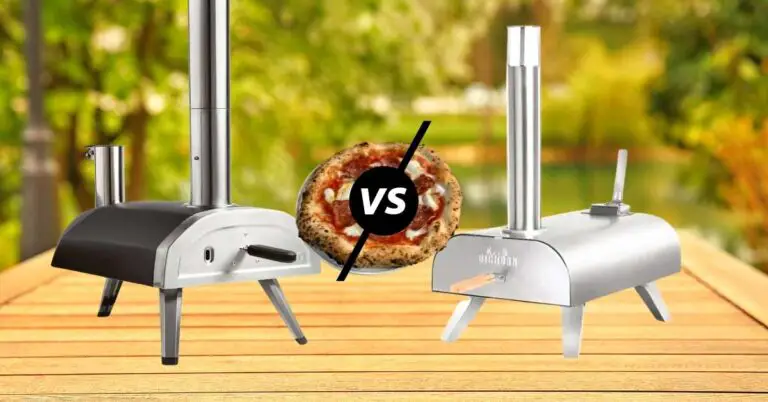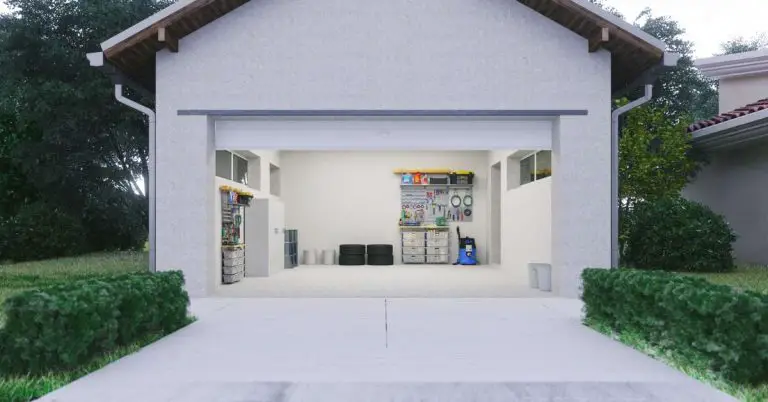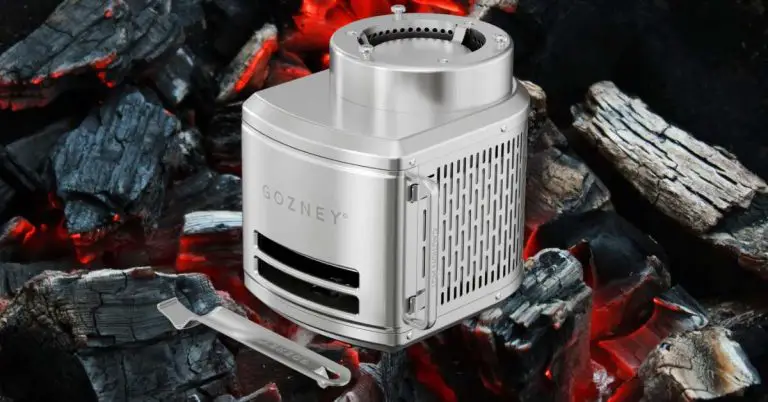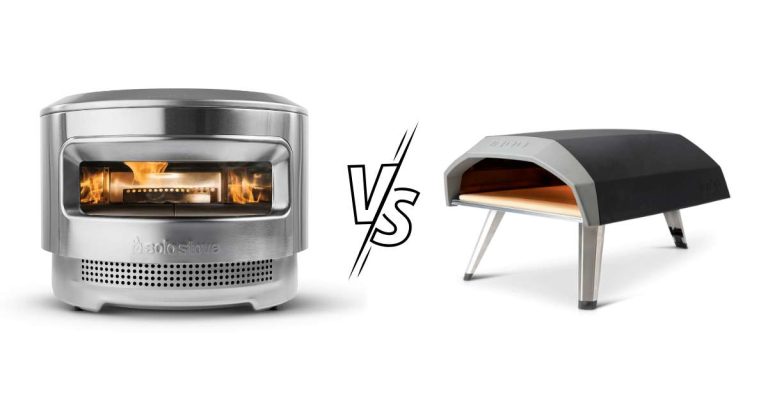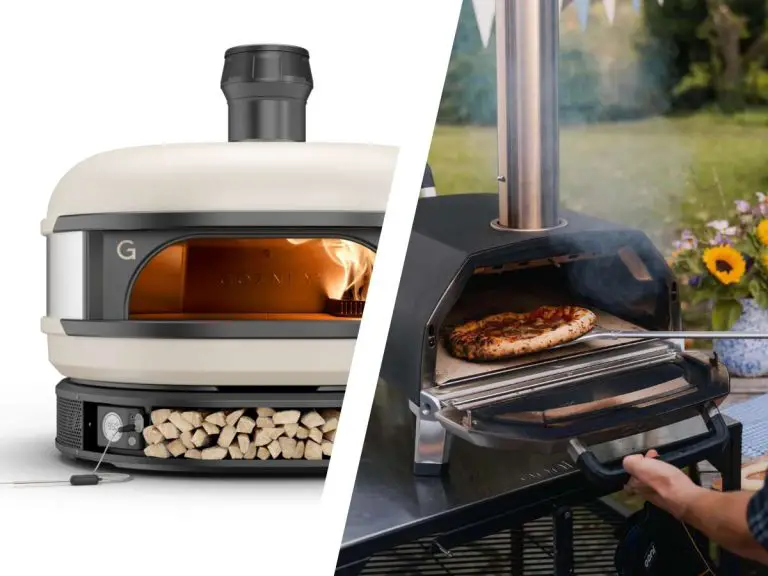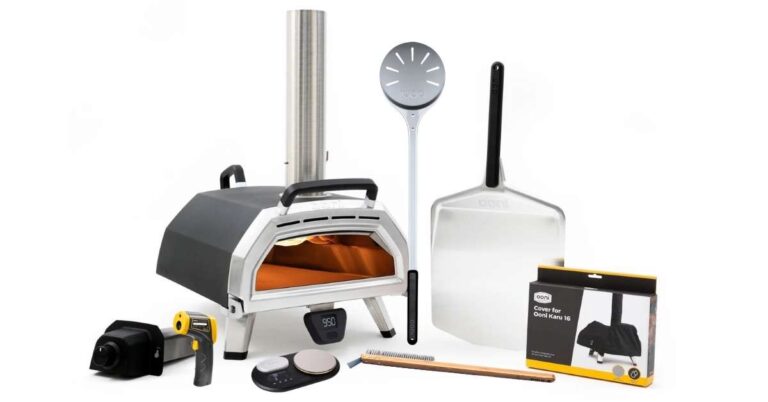Is a Wood-Fired Pizza Oven Better Than Gas? Authenticity vs Convenience Explained
When it comes to the best outdoor pizza ovens, there are two primary choices: wood and gas. A wood-fired oven offers a traditional pizza making experience, while gas (usually propane) is much more convenient and doesn’t have much of a learning curve. So, with that in mind, is a wood-fired pizza oven better than gas?
The truth is, you can make amazing pizza in either a wood-fired or a gas powered pizza oven. The only real difference between the two in terms of how the pizza comes out is in the taste. The smoke from a wood-fired oven infuses into the pizza and gives it a smoky flavor—this is something you can’t easily reproduce with a gas oven.
That said, there are some serious considerations to take into account beyond just taste. If you’re not experienced with managing an open flame, wood-fired pizza ovens can come with a steep learning curve. Many people give up trying (or think their oven is defective) when they can’t manage to keep the temperature high enough long enough for their pizza.
By contrast, gas powered ovens can be fired up at the push of a button and the flame is managed with easy control dials. This means you can be making pizza in as long as it takes the oven to heat up without any worry about the temperature being too high or low. For this reason, I generally recommend gas pizza ovens to anyone who isn’t specifically experienced with wood (or eager to learn).
Another option is to go with a multi-fuel pizza oven model, like the Ooni Karu 12G which burns wood and gas. If you specifically want wood, the Ooni Fyra 12 uses wood-pellets exclusively, which are a lot easier to use and master than traditional hardwood logs. I fully recommend either of these pizza ovens.
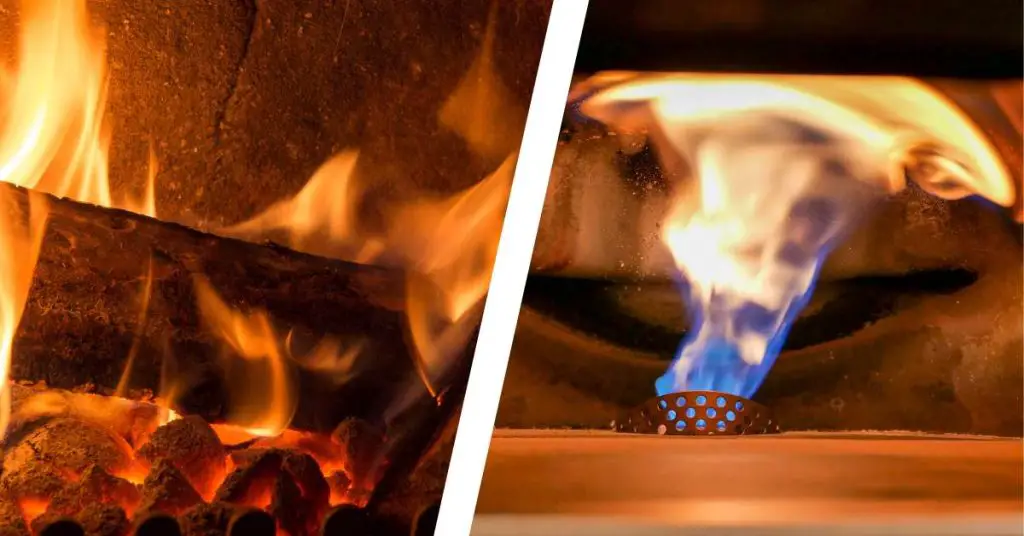
What Is A Wood-Fired Pizza Oven?
Before diving into the oven comparisons, it helps to understand what makes wood-fired pizza unique. Wood-fired pizza ovens and the art of making Neapolitan style pizza originated in Naples, Italy sometime around the 18th century. This rich culture and tradition continues today.
Early wood-fired ovens were typically built from brick and fueled with hardwood kindling. The domed oven shape helps circulate heat and allows a pizza to be rapidly cooked at high temperatures up to 1000°F. At this blistering heat, pizzas only need around 60-90 seconds to bake with a charred, bubbly crust.
Wood fire gives off a signature smoky flavor to the pizza. When combined with high-quality ingredients, like fresh mozzarella, basil, tomatoes, and olive oil, wood-fired cooking allows the simplicity and freshness of ingredients to shine.
For real Neapolitans, the art of wood-fired pizza represents generations of culture and pride. Beyond just a meal, it’s an experience centered around quality ingredients and family traditions. The technique has been passed down through pizza making families for centuries.
Today, restaurants around the world try to recreate authentic wood-fired pizza, with varying success. Specialty ovens imported from Italy can cost tens of thousands of dollars. These high prices demonstrate the value placed on honoring tradition and unlocking the iconic flavors of a true wood-fired pizza.
Related Post: Best Electric Indoor Pizza Ovens
How Wood-Fired Ovens Work
At the heart of wood-fired pizza is…you guessed it, a wood-fired pizza oven! Let’s look closer at how these ovens work their magic:
- Fueled by hardwood logs burned within the oven chamber
- Masonry construction – usually brick, clay, or stone
- Intense heat generated from fire – up to 1000°F
- Domed oven shape circulates heat for even cooking
- Temperature monitored and controlled by adjusting the flame
- Flame requires constant tending to keep the oven hot
- Real wood smoke flavors the pizza as it bakes
- Neapolitan pizzas bake in 60-90 seconds at max temps
Wood-fired ovens create the quintessential environment for perfect Neapolitan style pizza characterized by a charred, a tender middle, and smoky flavors. The exceptionally high heat of a wood-fired pizza oven is a great pair for fresh ingredients that retain nutrients and moisture when cooked quickly.
Managing the flame in a wood-fired oven is an art unto itself with a relatively steep learning curve. The flame must be closely controlled by properly stoking the fire during cooking and allowing it to burn down when you’re finished.
How Gas Pizza Ovens Work
Gas pizza ovens provide a convenient, versatile alternative to traditional wood-fired cooking. Here’s an overview of how they work:
- Typically fueled by liquid propane or natural gas
- Contained flame burns cleanly within a small chamber
- Electric ignition eliminates need to manually light
- Temperatures around 500-1000F
- Digital or analog dials control temperature
- Heat is easily adjustable during cooking
- Oven reaches set temp rapidly after lighting
- No smoke flavor imparted during baking
When making pizza at home, gas ovens offer performance and the convenience of not having to manage a flame. They also take up less space and don’t produce smoke, which makes them ideal for small backyards and balconies. Basically, you just turn on the gas, set the temperature, and that’s all there is to it.
The main trade-off with a gas powered pizza oven is that it won’t give the pizza the same smoky flavor as a traditional wood-fired oven. But the truth is most people won’t notice a huge difference and you can still get the same quintessentially Neapolitan crust using gas.
Comparison of Temperature Control
One of the key differences between wood-fired and gas powered pizza ovens comes down to how easy it is to manage the temperature of the oven. In particular, how easy it is to raise or lower the temperature once the oven has already been fired up.
Wood-Fired
- Capable of reaching 1000°F or hotter
- Ideal for fast Neapolitan pizza around 850-950°F
- Temperature controlled by manually adjusting the wood fire
- Takes experience to actively maintain desired temp
- More prone to temp fluctuations during cooking
Gas
- Same 1000°F max temperatures
- Set the temp set using a gas control knob
- Consistent, even heating with minimal fluctuation
- Easy to adjust temp as needed while cooking
Wood-fired ovens can more easily hit higher peak temperatures thanks to the intense direct heat of a wood fire, but this comes at the cost of less control. If you don’t have experience working with a wood fire, you might have trouble hitting the right temperatures or maintaining that heat during the entire cooking process.
Gas ovens can reach the same high temperatures as wood, but it might take longer to get there. In either case, the temperature of a gas pizza oven is much easier to control and maintain over long periods. It’s hard to beat the convenience and consistency of a gas powered oven.
Maintenance and Cleaning Comparison
Besides heat, another key difference between wood-fired and gas powered pizza ovens is in the general maintenance and cleanup before and after each cook.
Wood-Fired Maintenance
- You need to sweep out any ash before and after each pizza
- Soot needs to be wiped clean from the baking surface
- The chimney flue needs regular brushing
- Floor bricks may require replacing over time (not likely but possible)
- Only with proper care will your oven continue making great tasting pizza
Gas Oven Care
- Very little soot produced internally
- Easy wipe downs of exterior
- Occasional burner inspection (usually not necessary)
- Minimal wiping and brushing of interior after each cook
- Maintenance largely just exterior cleaning to keep it looking nice
The combustion of wood within the oven leads to significant ash and soot accumulation over time in wood-fired ovens. Keeping the oven interior and chimney cleaned improves airflow and ensures optimal performance and a clean tasting pizza.
Gas ovens essentially eliminate the dirty cleanup associated with wood-fired cooking because there is no solid fuel combustion and therefore no ash. A simple wipe of the ovens interior and exterior keeps it looking and working like new for years. Without smoke and ash to deal with, gas ovens offer (relatively) hassle-free care.
Evaluating Size and Spatial Needs
The size and space required for installing wood-fired versus gas powered pizza ovens is another important difference to consider:
Wood-Fired Ovens
- Large footprint for oven itself
- Additional room needed for wood storage
- Permanent outdoor installation ideal
- Masonry construction makes them heavy
- Built on-site during installation
Gas Ovens
- More compact and portable size options
- Many wheeled models exist for mobility
- Freestanding units perfect for patios
- Indoor installation possible if vented
- Easy DIY home assembly
The fuel source can greatly affect the overall size and placement considerations for each oven type. For wood-fired, both a potentially bulky oven and wood storage have to be accounted for when planning on where to put it.
On the other hand, gas ovens generally take up less space pound for pound. Smaller units can be setup on a balcony or patio. Ventilation is still needed, but an indoor setup is technically possible (but not recommended) if you know what you’re doing. The flexibility of propane suits tight spaces, which is why they’re so often used in small commercial establishments and small apartments/condos.
Of course, a lot of this is assuming that you’re using a traditional fixed pizza oven. If you’re using a portable pizza oven, both wood-fired and gas powered pizza ovens can fit into almost any space, as long as you have a well ventilated space. This is especially true if you’re using some of the more popular Ooni and Gozney pizza ovens.
Cost Comparisons
Upfront purchase price presents another contrast between wood-fired and gas ovens:
Wood-Fired Oven Cost
- Artisan-crafted units start at $5,000-$10,000+
- DIY construction reduces costs but adds labor
- Imported Italian ovens fetch upwards of $10k
- Long lifespan if properly maintained
- Greater value for avid pizza makers
- Portable units are much cheaper, starting at $200 for basic models
Gas Oven Cost
- As little as $200 for basic portable models
- High-end commercial units can go for $2,000-$4,000
- Much lower purchase price on average
- Great value for casual pizza makers
- May need replacing sooner than wood-fired if the burner stops working
Perks of Wood-Fired Ovens
- Iconic, true, smoky Neapolitan flavor
- Blistering hot temps for fast baking
- Beautiful focal point for an outdoor kitchens
- Radiant oven heat for cooking other foods
- Gathering place for family and friends
- Artisan craftsmanship and quality materials (model specific)
- If it’s made well, it can add value to your property
Benefits of Gas Ovens
- Affordable convenience
- Precise temperature controls
- Compact and portable size
- Short preheating times
- Easy ongoing maintenance
- Lower long-term costs
- Flexible installation options
Wood-Fired vs Gas Pizza Ovens: Key Considerations Before You Buy
When deciding between wood-fired and gas pizza ovens, keep the following things in mind:
Wood-Fired Ovens
Best for pizza purists wanting authenticity. Requires commitment to learning how to manage an open flame. Potentially high upfront cost but enduring value. Maximum flavor and tradition.
Gas Ovens
Best for convenient cooking and casual use. Choose for ease. Lower price point but you might have to replace the burner if it malfunctions.
Cooking Goals
If you want authentic Neapolitan style pizza, go for wood-fired. You can make great Neapolitan with gas as well, but you won’t get the smoke infused crust.
Space Limitations
If you’re working in a confined space, gas is the way to go. Wood-fired needs more room for the oven and fuel storage.
Budget Reality
Gas is likely the friendlier choice for limited budgets, especially if you already have access to a propane line. Wood-fired makes sense for devoted pizza makers who are willing to pay for fuel and do regular cleaning.
Final Thoughts on Choosing Your Oven
At the end of the day, deciding between a wood-fired or gas powered pizza oven comes down to aligning features and benefits with your tastes and lifestyle.
For purists looking for authenticity above all, a real wood-fired oven delivers in every way. The smoky flavors and connection to history make the whole thing worthwhile.
Yet for easy home pizza nights, gas is much more convenient. With minimal effort, gas ovens serve up tasty pizzas at the turn of a knob. For most people, gas is the most logical option in terms of both features and price.
There’s no objectively right or wrong option. Only you know whether the flavor and timeless charm of wood-fired outweighs the convenient simplicity of gas…or vice versa. Choose what best fits your pizza goals, pizza preferences, and lifestyle. Then get ready to enjoy the pleasures of homemade pizza!
Key Takeaways Comparing Ovens
- Real wood-fired ovens reach 1000°F+ temps perfect for Neapolitan pizza with a crisp, smoky crust.
- Gas ovens don’t burn as hot as kiln-dried hardwood, but provide push-button temperature control and management.
- Wood-fired ovens require significant maintenance like removing ash and cleaning soot.
- Gas ovens only need occasional exterior wipe downs for easy, hassle-free care.
- Compact gas oven size and portability contrasts the substantial space wood-fired ovens and fuel storage require.
- Traditional wood-fired flavor is unmatched, but gas ovens offer flexibility and convenience that may suit casual use better.
- Wood-fired ovens command a premium price but can serve homes for decades when properly maintained.
- Gas ovens carry lower upfront costs, though their lifespan is shorter before needing full replacement.
- For authenticity purists, wood-fired reigns supreme. For convenience and accessibility, gas ovens win out.
Related Question
Can you taste the difference between wood and gas pizza oven?
In a side by side comparison, you can definitely taste the difference between gas and wood-fired pizza. The taste of the smoke from the wood flame infuses into the crust and toppings while it cooks. That said, a wood-fired pizza only cooks for a couple of minutes max, so the taste difference between wood and gas is (realistically) pretty minimal.
What is the best fuel source for pizza oven?
There are some qualitative taste differences from one fuel source to the next, but I recommend choosing the fuel source that fits your pizza making preferences and lifestyle. If you prefer authenticity and smoky flavors, then wood or charcoal is the easy choice. If you prefer convenience and fuel efficiency, then gas is the way to go.

